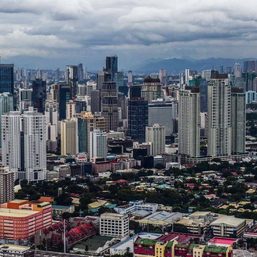SUMMARY
This is AI generated summarization, which may have errors. For context, always refer to the full article.
![[In This Economy] Is the Philippine economy stable?](https://www.rappler.com/tachyon/2024/05/philippine-economy-stable-may-10-2024.jpg)
On TikTok, username nikkacg posted a viral video where she talked about the state of the Philippine economy. “Many Filipinos don’t know this,” she said, “but our country has a very stable economy.” And this is “regardless of the administration we have.”
She added that “our country is at the same income level as Singapore during the late ‘60s.” But “that doesn’t mean we’ll never get to their point.”
She also cited the Philippine Development Plan produced by the National Economic and Development Authority (NEDA), a document that “gets better and better” with each administration, “and there comes growth, there comes a lot of change and opportunity for a higher income country.”
Almost 400,000 people have viewed this on TikTok. But is it accurate? Let’s break it down.
Typically, you can say that an economy is stable if it meets the following criteria:
1) Low and stable inflation
2) Steady growth
3) Low unemployment
4) Manageable deficit and debt
5) Healthy financial sector
This is by no means an exhaustive list, but it’s a pretty good starting point.
Data released by the Philippine Statistics Authority (PSA) this week can help us assess the economy’s stability.
As for #1, it turns out that inflation inched up to 3.8% in April 2024. Sure, this is within the government’s 2-4% target range. But rice prices are driving up food inflation, which in turn, is stoking overall inflation. Since the poor spend a larger proportion of their income on food, they are currently experiencing inflation at a much higher rate of 5.2%!
Figure 1.
The huge swing of inflation in the past two years, peaking at 8.7%, also betrays that inflation hasn’t been low and stable of late. Prices are clearly unstable, and the Marcos government could be doing more to reverse that.
As for #2, growth is indeed stable but only if you mean that there are no extreme swings of gross domestic product (GDP) growth.
Data released by the PSA (this week, too) show that economic growth has been anemic of late. In the first three months of 2024, GDP grew by 5.7% compared to the same period in 2023.
Figure 2.
Note that this is lower than the median forecast, and a tad below the 6-7% growth target of the government for this year. That means that to achieve at least 6% growth this year, growth in the next three quarters must all be no less than 6.1%.
Note, too, that government already lowered its growth target from 6.5-7.5% because of gloomy global prospects. But still, they couldn’t meet their lower target.
Before the pandemic, GDP grew by at least 6% each quarter. But post-pandemic, it’s becoming harder and harder to achieve that.
A closer look at the data will tell you why. Consumption spending is contributing less and less to growth (likely because of the combination of elevated prices and higher interest rates). Investments contributed nearly nothing to growth, as with government spending. In other words, all key drivers of spending growth have slowed down. Does that spell a “stable” economy?
As for #3, the PSA also released data this week on labor statistics. They said that the unemployment rate inched up to 3.9% in March 2024, translating to about 2 million unemployed people in the labor force.
One possible reason for this is that a greater proportion of people aged 15 and up joined the labor force, but not all found jobs.
On the one hand, unemployment is indeed quite low and is, in fact, decreasing over time. But for a country like ours, studies have said that the underemployment rate is an arguably better metric of workers’ welfare; as of March, the underemployment rate was as high as 11% (it has long been in the double-digits).
Certain sectors of the labor force are also suffering a lot, including agriculture, which reportedly shed a whopping 318,000 jobs from February to March 2024, amid El Niño. Low income, poor prospects, and climate risks are driving people in agriculture into worse poverty. Even fisherfolk are refusing now to go out at sea because of the intense heat.
Other sectors are feeling pain as well. Delivery riders continue to ply the streets under intense heat and without enough work benefits. Workers in the business process outsourcing (BPO) industry, meanwhile, face threats from the exponential growth of artificial intelligence (AI). Wages also can’t keep up with sky-high prices.
And underlying many labor market problems, we have a broken educational system that has led to a 90% learning poverty rate. How productive can our labor force be with such poor education?
So even if, on the surface, our labor statistics look good, they can only tell us so much. And we can settle for a better labor market than the one we currently have.
As for #4, the debt-to-GDP ratio in the first quarter of 2024 was still a bit higher than 60%, a far cry from the less than 40% we had before the pandemic. And this means that the total debt was at a colossal P14.9 trillion.
Expect the debt to balloon further because government revenues will continue to trail spending in the coming years.
As for #5, while the banking sector can be said to be healthy and stable, there are risks including those imposed by the Marcos administration itself.
This includes the ongoing Maharlika Investment Fund, which forcibly obtained billions of pesos from the Bangko Sentral ng Pilipinas (BSP) and state-owned banks (namely the Land Bank of the Philippines and the Development Bank of the Philippines).
By siphoning money away from these financial institutions, the government is not only delaying the capital-raising activities of the BSP, but also putting at risk the biggest state-owned banks, which need to maintain sufficient capital according to international standards.
To recap: inflation has experienced wild swings of late, growth has been anemic (and pulled down since the pandemic), the underemployment rate is still high, wages are still stagnant, the debt continues to balloon in earnest, and there are financial sector faces risks coming from the government itself.
Going back to nikkacg’s post, the economy is not as stable as she thinks it is.
By the way, the Philippine Development Plan is just that – a plan. And even the best of economic plans can result in bad or subpar outcomes, if good governance is sorely lacking. – Rappler.com
JC Punongbayan, PhD is an assistant professor at the UP School of Economics and the author of False Nostalgia: The Marcos “Golden Age” Myths and How to Debunk Them. In 2024, he was given The Outstanding Young Men (TOYM) Award for economics. JC’s views are independent of his affiliations. Follow him on Twitter/X (@jcpunongbayan) and Usapang Econ Podcast.
1 comment
How does this make you feel?




![[Vantage Point] Philippine economic reforms run into headwinds](https://www.rappler.com/tachyon/2024/05/ph-economic-headwind-may-2024.jpg?resize=257%2C257&crop_strategy=attention)




![[In This Economy] Part 2 | POGOnomics: Are we banning POGOs out of fear, outrage, not rational thought?](https://www.rappler.com/tachyon/2024/06/thought-leaders-pogonomics-part-2b.jpg?resize=257%2C257&crop=292px%2C0px%2C720px%2C720px)
![[In This Economy] POGOnomics: Weighing the costs and benefits of POGOs](https://www.rappler.com/tachyon/2024/06/thought-leaders-pogonomics-part-1.jpg?resize=257%2C257&crop=279px%2C0px%2C720px%2C720px)



![[In This Economy] Is the Philippines quietly getting richer?](https://www.rappler.com/tachyon/2024/04/20240426-Philippines-quietly-getting-richer.jpg?resize=257%2C257&crop=194px%2C0px%2C720px%2C720px)
![[Vantage Point] Joey Salceda says 8% GDP growth attainable](https://www.rappler.com/tachyon/2024/04/tl-salceda-gdp-growth-04192024.jpg?resize=257%2C257&crop_strategy=attention)




![[In This Economy] Peso approaches P60 per dollar once more. So what?](https://www.rappler.com/tachyon/2024/05/TL-peso-dollar-economy-may-24-2024.jpg?resize=257%2C257&crop=302px%2C0px%2C720px%2C720px)
Thanks to Prof. JC Punongbayan for debunking the “nikkacg” claim about our economy. The problem is, how many of the 400,000 viewers who saw her TikTok post believed in what she claimed? If any of these viewers believed in what she claimed, then disinformation has been committed.